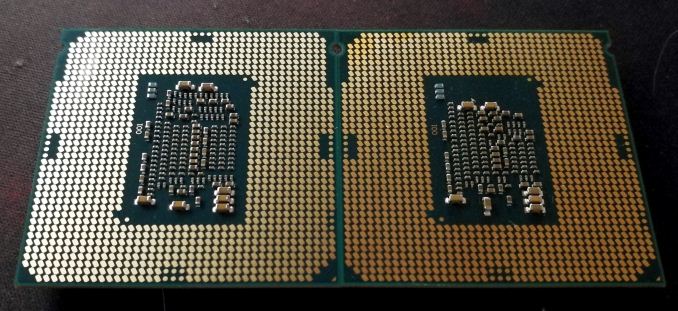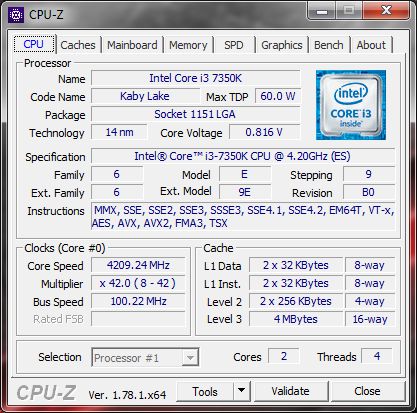The Intel Core i3-7350K (60W) Review: Almost a Core i7-2600K
by Ian Cutress on February 3, 2017 8:00 AM ESTCasual Enthusiasts Rejoice
No matter your taste for being labeled, the PC and gaming market is awash with different segments that loosely collate different requirements. Some want high-performance at any cost, others are power conscious, and some want the best gaming performance for their budget. For this latter group, the Core i3-7350K is a serious contender to throw some money at.
In our single GPU tests (which are admittedly showing their age a small bit), at 1080p and 4K, the Core i3-7350K was on par with the Core i5-7600K and Core i7-7700K. The Core i3 part is not seriously marketed at SLI/CFX configurations, so maintaining a good level performance at mainstream resolutions using a single graphics card is important in this performance for a 'budget' build. The high single core frequency at 4.2 GHz, or more when overclocked, ensures that the Core i3 hits a high level of performance in most DX11 gaming where performance can differ. Out of our gaming tests, the Core i5-7600K offered a small gain with mid-range GPUs on Grand Theft Auto, but for the most part performance was on par or within a few percent.

Core i7-7600K (left) and Core i3-7350K (right)
For underlying performance, the Core i3-7350K is one of the fastest single threaded performers on the market. The combination of 4.2 GHz and Kaby Lake IPC means that only the i7-7700K is the only one that beats it. For basic programming and web work, having one of the fastest chips on the market may help improve the experience. However, starting to add more complex work in to the mix shows that the dual core chip can be a bottleneck – any workload with heavy threads, such as compute (compression, rendering, matrix compute), is going to hand a performance advantage to a Core i5. A good example of this is Agisoft: the Core i5-7400 (which costs $14 more, quad core, 3.0-3.5 GHz) completes the work ~10% quicker.
For overclocking, the Core i3-7350K matches the other Kaby Lake overclocking parts. Our retail stepping sample achieved 4.8 GHz without any AVX offset, similar to our Core i5-7600K and Core i7-7700K. One of the upsides of the overclock was the power consumption: due to the 1.2 volts applied to the CPU at stock frequencies, our overclock only produced another +12W in power consumption. It was perhaps surprising that the Core i5-7400 had a much lower power consumption than the dual core, but the high base frequency leads to a higher stock voltage which translates to power consumption.
What would be interesting to see is how the power consumption changes with some of the lower clocked Core i3 parts. From our overclocking/underclocking results, a 4.0 GHz Core i3 at 1.100 volts would only consume 43W.
Ultimately, the state of the Core i3-7350K depends on what you are interested in as an enthusiast.
- Overclocking? It’s a fun choice.
- Responsiveness? Top class.
- Mainstream 1080p Gaming? A cheaper equivalent to the Core i5.
- Power? A lower clocked i3 is better on efficiency.
- Heavy workloads? Spend $14 and go for a Core i5.
The idea internally (inside my head) is to rerun this set of interesting Intel CPUs on Windows 10 with newer DX12 games and newer GPUs over the next few months. It’s going to be fun. I think.
More about Kaby Lake
For readers that want a more in-depth take on Kaby Lake as a platform, we have a dedicated article full of information for you. We also have other articles in our Kaby Lake bonanza.
Other articles include:
Intel Launches 7th Generation Kaby Lake (Overview and Core Improvements)
The Intel Core i7-7700K Review: The New Out-of-the-box Performance Champion
The Intel Core i5-7600K Review: The More Amenable Mainstream Performer
The Intel Core i3-7350K Review: When a Core i3 Nearly Matches the Core i7-2600K (This Review)
Still to come
Calculating Generational IPC Changes from Sandy Bridge to Kaby Lake
Intel Core i7-7700K, i5-7600K and i3-7350K Overclocking: Hitting 5.0 GHz on AIR
Intel Launches 200-Series Chipset Breakdown: Z270, H270, B250, Q250, C232
Intel Z270 Motherboard Preview: A Quick Look at 80+ Motherboards











186 Comments
View All Comments
realneil - Wednesday, February 8, 2017 - link
^^This^^Intel is ~finally~ facing some upcoming opposition in the CPU arena and they're trying to fill in some perceived gaps in their CPU lineup.
After Ryzen is released, expect to see multiple product changes from team blue right away to combat AMD's offerings.
CaedenV - Friday, February 3, 2017 - link
I think it will make more sense with next gen parts. I suspect we are watching a shift in the lineup that is slowly rolling out.celeron - duel core
pentium - entry duel core with HT (limited cache/clock/iGPU)
i3 - high-end duel core HT (essentially unchanged)
i5 - quad core with HT (today's i7)
i7 - 6-12 core with HT (today's LGA2011 line)
So why no straight quad core part? Well, 2 reasons.
1) it probably isn't needed. The original i5 parts were just i7s with broken HT cores that were disabled. I imagine most chips coming out now have perfectly fine HT cores, so they are artificially disabled. This increases the cost of the binning process, and reduces profit on a per-chip basis... especially if they can sell the same part somewhere between today's i5 and i7 price.
2) Right now I would wager that most home builders buy either an i3 because they are budget conscious, or i7 because their pride will not let them get anything less than the best. But the i7 that they buy is the lower margin 'consumer' i7 chips rather than the premium laiden LGA2011 i7 chips that make buku bucks on both CPU and chipset sales. Moving the i7 lineup to start at ~$500 instead of ~$280 would more than off-set the number of people willing to step down to an i5 chip; even if the step down is in name only and really the i5 would be more affordable while offering traditionally i7 performance levels.
3) Bonus reason; Ryzen chips are expected to land near today's i5/i7 chips in performance, and Intel does not want AMD to be able to say 'our chips are as fast as an i7 but only cost what an i5 does'. Instead, intel want's it's smug users (like myself) to say 'ya, that Ryzen is not a bad chip, but it doesn't hold a candle to my i7'. Real world benchmarks be damned, it is what people are going to say.
Alexvrb - Friday, February 3, 2017 - link
I wouldn't necessarily bet that more home users buy i7s than i5s. I personally know two gamers that recently built i5 systems because they wanted more oomph than a 2C/4T i3, but didn't want to spend money on an i7. Why? So they could spend more money where it makes the biggest difference... the graphics card. An i5 provides plenty of CPU horsepower for games, and gives you another $100 or so to spend on better graphics.I think their judgement was sound. I doubt they are alone in this kind of assessment. I think you're letting your admitted i7 smugness cloud your judgement a little bit.
Tunnah - Saturday, February 4, 2017 - link
I build PCs for my friends, and advise people on what to buy, and I don't know a single person apart from myself who has an i7 (and only know of 1 person who has an i3 but he uses his box for media). i5 is a perfect chip for casual users who use the PC mostly to game.Hell the only reason I have an i7 is for Civ VI ha.
Alexvrb - Saturday, February 4, 2017 - link
Bingo!Meteor2 - Sunday, February 5, 2017 - link
i7s (or Xeons) are nice if you're encoding a lot of x265 video (x265 gives better quality per bitrate than hardware encoders). That's the only desktop use case I can think of.Meteor2 - Sunday, February 5, 2017 - link
...or apparently not, according to a comment way below, where a 12C/24T Xeon barely does double digit x265 FPS.bak0n - Monday, February 6, 2017 - link
Exactly why I have an I5 3570k. My next build will either be a ryzen (depending on wither it hits expectations), or the I5 of whatever generation is out when I'm ready to buy. To big of a price jump to the I7 for a hard core 1080P maxed setting gamer, but not to much of a price jump over the i3's. That is, until now with the i3k which I may actually give a second look at.DiHydro - Monday, February 6, 2017 - link
I fit into that category with one caveat, I also do some 3d modeling and rendering. This pushed me to the i7-2600k about four years ago, and I still don't feel that my CPU is the limiting factor on my PC.Byte - Saturday, February 4, 2017 - link
Very true, most customers want the best or the cheapest. Changing the lineup liek that would make it easier.